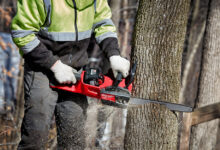Contents
- 1 Introduction: Navigating the Maze of Chainsaw Lubrication
- 2 Choosing the Right Chain Oil
- 3 Manual or Automatic Oiling?
- 4 Chain Lubrication Frequency
- 5 Bar Lubrication
- 6 Inspecting and Cleaning the Oil System
- 7 Lubrication Benefits: Unveiling the Advantages
- 8 Lubrication Weaknesses: Understanding the Limitations
- 9 Chainsaw Lubrication Tips: A Comprehensive Reference Guide
- 10 FAQs: Resolving Common Lubrication Queries
- 11 Conclusion: Embracing Chainsaw Lubrication Excellence
Chainsaws are indispensable tools for a wide range of outdoor tasks, from felling trees to cutting firewood. However, to ensure optimal performance and safety, proper lubrication is paramount. It keeps the chain moving smoothly, reducing friction and wear, and prevents the bar from overheating. This comprehensive guide will delve into the intricacies of chainsaw lubrication, providing you with indispensable knowledge for maintaining a well-oiled and efficient saw.
Chainsaws operate under demanding conditions, encountering friction, heat, and contaminants. Without adequate lubrication, the chain and bar can quickly deteriorate, leading to premature failure. Proper lubrication solves these challenges, forming a protective layer that reduces metal-on-metal contact. It also flushes away sawdust and debris, preventing clogging and ensuring smooth operation. Embracing these lubrication practices will extend the lifespan of your chainsaw, enhance its cutting efficiency, and safeguard your safety.
Choosing the Right Chain Oil
The foundation of effective chainsaw lubrication lies in selecting the appropriate chain oil. Look for a high-quality product specifically designed for chainsaws. These oils have the ideal viscosity to penetrate the cutting components, providing adequate lubrication without gumming up. Avoid using engine oil or other substitutes, as they may not offer the necessary protection and can damage your saw.
Manual or Automatic Oiling?
Chainsaws offer two lubrication methods: manual and automatic. Manual oilers require you to manually apply oil to the chain before and during operation. While less convenient, this approach gives you complete control over the lubrication frequency. Automatic oilers, on the other hand, continuously dispense oil from a reservoir, ensuring a steady supply to the cutting components. They are more convenient but require regular monitoring to ensure the oil level is maintained.
Chain Lubrication Frequency
The frequency of chain lubrication depends on several factors, including the type of wood you’re cutting, the cutting intensity, and the weather conditions. As a general rule, lubricate the chain every time you refuel or at least every 30 minutes of continuous operation. If you encounter hard or dense wood, increase the lubrication frequency to prevent premature wear.
Bar Lubrication
In addition to the chain, the bar also requires occasional lubrication. Apply oil to the groove along the underside of the bar, where the chain rides. This lubrication prevents metal-on-metal contact and reduces friction, extending the life of the bar.
Inspecting and Cleaning the Oil System
Regularly inspect the oil system for any leaks or blockages. Clean the oil reservoir and the oiler holes periodically to remove any debris that might interfere with the oil flow. Neglecting these maintenance tasks can result in inadequate lubrication and potential damage to your chainsaw.
Lubrication Benefits: Unveiling the Advantages
1.
Reduced Friction and Wear:
Lubrication creates a protective film that separates the metal surfaces of the chain and bar, reducing friction and wear. This reduces the risk of premature damage and extends the lifespan of the cutting components.
2.
Heat Reduction:
Lubrication dissipates heat generated by friction, preventing the chain and bar from overheating. This overheating can lead to reduced cutting efficiency and potential component failure.
3.
Enhanced Performance:
A well-lubricated chainsaw cuts more smoothly and efficiently. The reduced friction allows the chain to move freely, resulting in improved cutting speed and reduced effort required from the operator.
4.
Reduced Clogging and Debri Removal:
Lubrication prevents sawdust and debris from accumulating on the chain and bar. The oil acts as a carrier, flushing away these contaminants and ensuring smooth operation.
5.
Corrosion Prevention:
The oil film created by lubrication also provides protection against corrosion caused by moisture and other environmental factors. This is particularly important for chainsaws that are used outdoors or stored in humid conditions.
Lubrication Weaknesses: Understanding the Limitations
1.
Oil Splatter:
Chainsaw lubrication can sometimes result in oil splatter, which can be messy and inconvenient. This is more common with manual oilers or when the oil flow rate is too high.
2.
Environmental Concerns:
Chain oil can be harmful to the environment if it is not disposed of properly. It is important to use biodegradable oils and to avoid spilling or over-lubricating the chainsaw.
3.
Cost of Oil:
Chain oil can be an additional expense, especially if you use your chainsaw frequently. However, the cost of regular oil changes is typically outweighed by the benefits of improved chainsaw performance and extended lifespan.
Chainsaw Lubrication Tips: A Comprehensive Reference Guide
| Tip | Description |
|---|---|
| Use High-Quality Chain Oil | Invest in a premium chainsaw oil that is specifically formulated for the demands of chainsaw operation. |
| Choose the Right Lubrication Method | Determine if manual or automatic lubrication is more suitable for your needs and usage patterns. |
| Lubricate Frequently | Establish a regular lubrication schedule based on factors such as wood type, cutting intensity, and weather conditions. |
| Lubricate the Bar | Do not neglect the bar; apply oil to the groove along the underside to prevent friction and wear. |
| Inspect and Clean the Oil System | Regularly check for leaks or blockages, and clean the oil reservoir and oiler holes to ensure proper oil flow. |
| Store the Chainsaw Properly | When not in use, store the chainsaw in a dry place to prevent oil leakage and contamination. |
| Dispose of Oil Responsibly | Use biodegradable oils and avoid spilling or over-lubricating to protect the environment. |
FAQs: Resolving Common Lubrication Queries
- What is the best type of chain oil?
Look for high-quality chain oils specifically designed for chainsaws, offering the optimal viscosity and additives for lubrication and protection.
- How often should I lubricate my chainsaw?
Lubricate the chain every 30 minutes of continuous operation or each time you refuel. Increase the frequency for hard or dense wood.
- What are the signs of insufficient lubrication?
Excessive noise, chain binding, and overheating are all indications of insufficient lubrication. Inspect the oil level and adjust the lubrication rate accordingly.
- Can I use engine oil for chainsaw lubrication?
No, engine oil is not suitable for chainsaw lubrication. It is too thick and can clog the oil system, leading to damage.
- What is the purpose of bar lubrication?
Bar lubrication prevents metal-on-metal contact and reduces friction between the chain and the bar, extending the lifespan of both components.
- How do I clean the chainsaw oil system?
Remove the bar and chain, and use a small brush or compressed air to clean the oil reservoir, oiler holes, and the groove along the underside of the bar.
- What should I do if I over-lubricate my chainsaw?
Wipe off excess oil from the chain and bar, adjust the lubrication rate, and run the chainsaw for a few minutes to distribute the remaining oil evenly.
- How do I store my chainsaw properly after lubrication?
Store the chainsaw in a dry place with the chain and bar facing down to prevent oil leakage and contamination.
- Can I use vegetable oil for chainsaw lubrication?
While vegetable oil is biodegradable, it is not recommended for chainsaw lubrication. It can gum up the oil system and provide inadequate protection.
- What are the consequences of neglecting chainsaw lubrication?
Neglecting lubrication can lead to accelerated wear of the chain and bar, overheating, reduced cutting efficiency, and premature failure.
- How often should I check the oil level?
Check the oil level before each use and refill it if necessary to maintain proper lubrication.
- What is the difference between biodegradable and non-biodegradable chain oil?
Biodegradable chain oil breaks down naturally in the environment, while non-biodegradable oil does not. Using biodegradable oil helps protect the environment.
- Can I use old or used chain oil?
Using old or used chain oil is not recommended. It may contain impurities or contaminants that can clog the oil system or damage the chainsaw.
Conclusion: Embracing Chainsaw Lubrication Excellence
Investing in proper chainsaw lubrication is not simply a task; it is an investment in the longevity, efficiency, and safety of your valuable tool. Incorporating these lubrication









